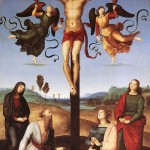For some time since I started this project, I’ve told people that BDSM, as we would recognize it, is a modern phenomenon. That is, it first appears in the 15th century, when writers outside the clergy start pondering why some men like to get whipped, and the Reformation gets underway. It didn’t exist before because the way culture viewed sexuality and play didn’t allow it.
I had anomalous data, of course, such as the story of Abelard and Heloise, who said he beat her out of love. I had planned on dismissing this as an isolated incident, and stuck to my thesis that kink is only about five centuries old.
As my research until now focussed on the 19th century, nothing came up that seriously challenged my assumption. But people kept insisting that it was older than that. Finally, the first book on Roman sexuality I got from the library (Roman Sex: 100 BC – AD 250, by John R. Clarke, 2003,Harry N. Abrams) forced me to junk all of that.
The Villa of the Mysteries is a large house in the preserved Roman city of Pompeii. Initially thought to be a brothel or temple because of the nude frescos on the walls, later archaeologists decided it was actually a private home and the art depicted a narrative about preparing young brides for marriage in the cult of Dionysius.
Reading the images from left to right around the room, the narrative starts with a woman in street clothes, then a mother with son, then a pregnant woman with a laurel crown carrying cakes, etc. The images are tranquil until a woman is startled; she draws away from something in surprise, her cape in violent motion over her.
The first image visible as a person enters the room is Dionysius sitting with his head almost in the lap of his lover Ariadne. To the right of them is an undressed woman kneeling before a large phallus in a basket, covered with purple cloth.
Up until this point, I didn’t view the images as sadomasochistic, but more as some kind of fertility rite. But then came the image that forced me to rethink everything.
Immediately to the right of the woman with the phallus in the basket is a standing female figure with dark wings. Clarke’s book identifies her as a “female demon.” Unlike the other female figures in the fresco, who are nude or in dresses, she wears boots or sandals, a knee length skirt and a belt of some kind. She’s dressed for fighting or something else athletic. Her right hand wields a cane or switch, in full backswing, apparently beating the next figure, on the other side of the room’s corner.
Here, a woman kneels, back and buttocks exposed, resting her face in the lap of another, clothed woman. After that, a nude woman dances with cymbals. The final image is a maidservant arranging a young woman’s hair in the style reserved for brides.
Although there are probably other interpretations to this work, the connection between sexual pleasure, physical pain, female grooming and fertility is clear to me. Beating is part of the process that includes ecstatic dancing, if not a prelude to it, and grooming before marriage. Bear in mind, this is a room in a private home, not a brothel or a temple, and the work may have been commissioned by and for the women of the home.
Until now, I had assumed that any cases of voluntary flagellation before the 15th century were primarily religious rituals, with sexuality component a secondary and disavowed aspect. The Mysteries Room fresco suggests that the two can’t be so neatly separated. The narrative shows flagellation as part of the marriage/fertility rite. I could argue that this shows erotic flagellation as part of a religious ritual performed once in a lifetime, and therefore isn’t a secular, recreational phenomenon like modern BDSM, but that would be a cop-out.
I have just begun to look at the Classical period, so I expect to find more items that suggest sadomaosochism goes back further than I thought.






